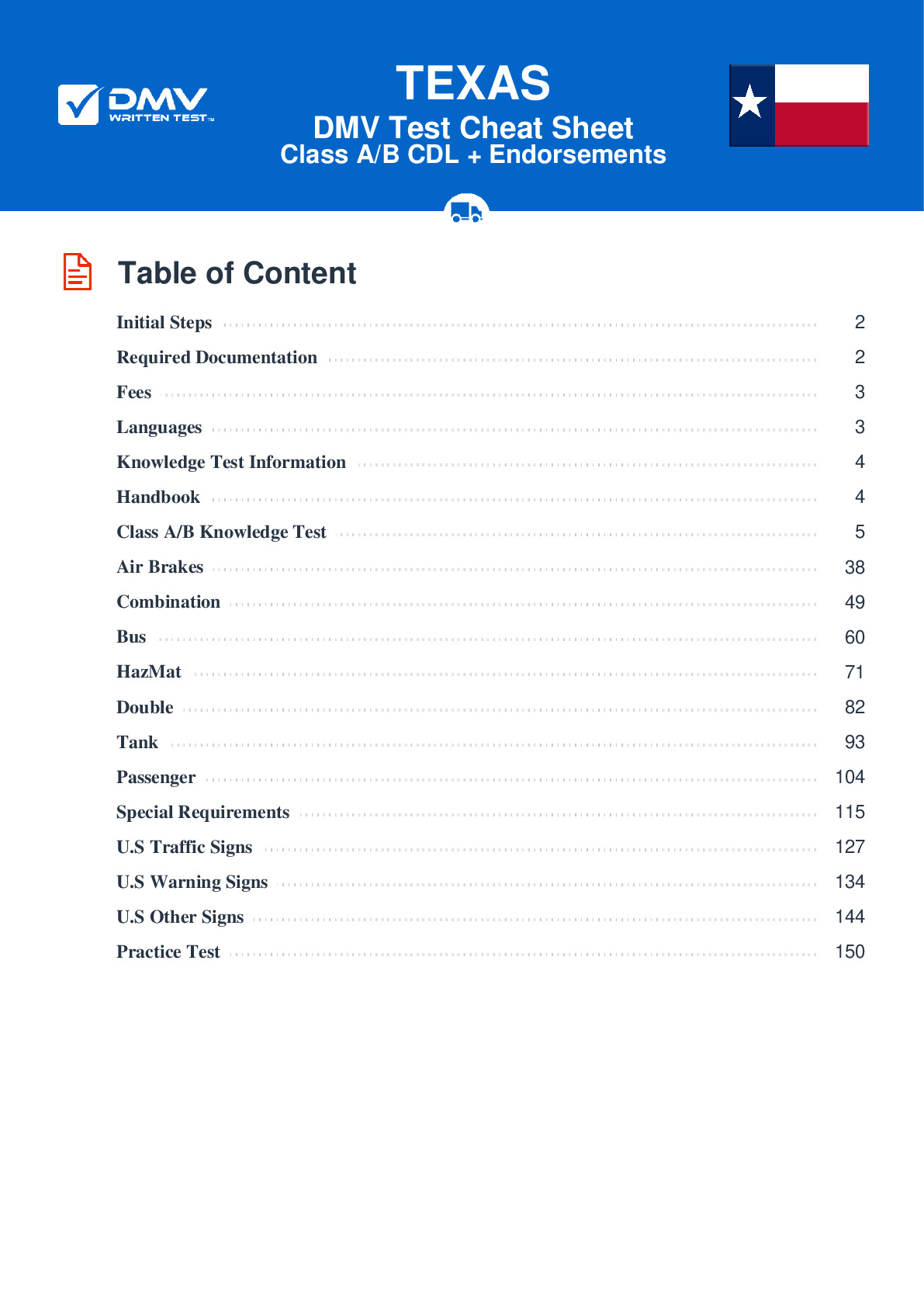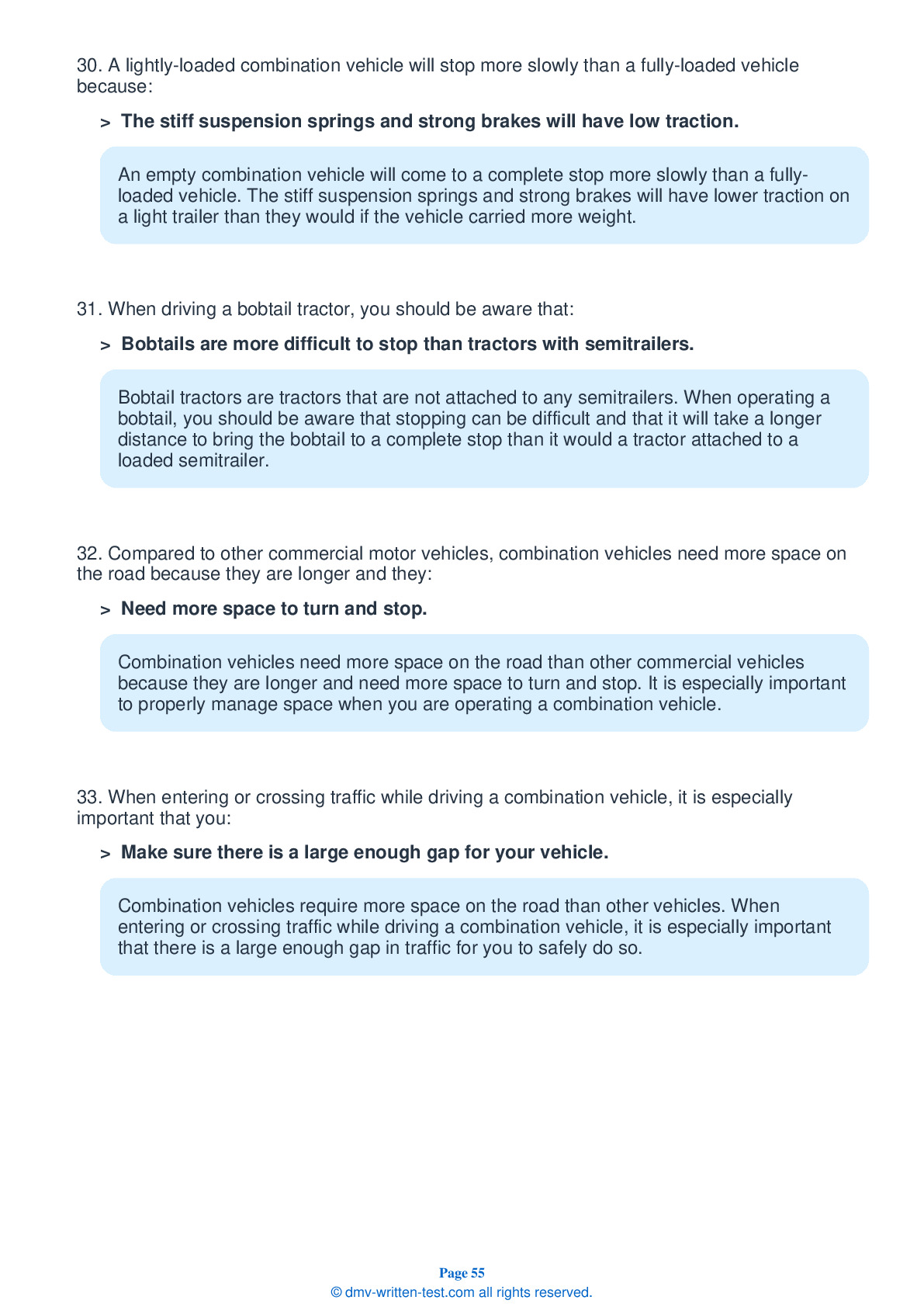Knowledge Test Class A
This license is required for driving any legal combination of vehicles,with a gross combination weight rating of 26,001 pounds or more, provided the GVWR of a trailer exceeds 10,000 pounds. To receive this license, applicants must pass a 70-question test. Test questions come from the Texas Commercial Motor Vehicle Drivers Handbook. Each question has four answer choices. To pass, applicants must answer 56 questions correctly. Test questions come from the Texas Commercial Motor Vehicle Drivers Handbook. Questions come from chapters covering: Introduction, Driving Safely, Transporting Cargo Safely, Air Brakes (if applicable), Combination Vehicles, Pre-Trip Vehicle Inspection Test, Basic Vehicle Control Skills Test and On-Road Driving. Endorsemetns that may be used with a Class A CDL are: Hazardous materials, Tank, Passenger, Doubles/Triples, HazMat and Tank, Air Brakes and School bus.
8. When driving with a load, the driver should:
Cargo and its securing devices must be inspected before starting a trip. After beginning a trip, the driver should check the load and securing devices within the first 50 miles on the road, every three hours or 150 miles traveled, and after every break.
9. When nearing a construction worker who is close to the road, you should:
When driving through work zones, you should make a particular point of reducing your speed when workers are on or near the road.
10. During exercises that are not the straight line backing exercise, you may exit your vehicle to check its position no more than:
A driver is allowed to exit their vehicle to check its position during any basic control skills test exercise. This action is called a "look." During the straight line backing exercise, a driver may not exceed one look. During any other exercise, a driver may not exceed two looks.
11. When passing another vehicle, you should:
It is always safest to assume that other drivers, bicyclists, and pedestrians don't see you. Be prepared for the possibility that they may suddenly move into your path. It may be safe to lightly tap your horn or flash your lights as you pass.
12. When checking the air and electrical lines during a vehicle inspection, all of the following should be true, except:
When examining the air and electrical lines as part of your vehicle inspection test, you must listen for leaks. Ensure that the air hoses and electrical lines are not cut, chafed, spliced, or worn. Make sure air and electrical lines are not tangled, pinched, or dragging against tractor parts.
13. If a truck's Anti-Lock Braking System (ABS) is not working:
If an ABS system fails, the vehicle will still have normal braking function. The driver should continue to drive and brake as they normally would.
14. What can change the height of a vehicle?
The added weight of a heavy load will make a vehicle sit lower than usual. A vehicle will often be taller when carrying a light load than when carrying a heavy load. If your vehicle fits under an overpass while carrying a full load, it is not guaranteed that it will fit under the same overpass if it is empty.
Frequently Asked Questions
To obtain a Class A CDL in Texas, drivers must first pass a written knowledge test and then a skills test. They must also meet certain medical and physical requirements and provide documentation of their driving history. Once they pass these tests and meet the requirements, they can apply for a Class A CDL license through the Texas Department of Public Safety.
1. Tractor-trailers: A combination of a tractor unit and one or more semi-trailers.
2. Double and triple trailers: A combination of two or three trailers connected to a single tractor unit.
3. Tanker vehicles: Vehicles designed to transport liquids or gases in bulk.
4. Livestock carriers: Vehicles designed to transport live animals.
5. Flatbed trucks: Trucks with an open cargo area that is typically used for transporting large items such as building materials and heavy equipment.
It's important to note that drivers with a Class A CDL license may also be required to obtain additional endorsements if they plan on operating vehicles that require specialized knowledge and skills, such as hazardous materials (Hazmat) or passenger vehicles.
1. Be at least 18 years old: You must be at least 18 years old to drive intrastate (within Texas) and at least 21 years old to drive interstate (across state lines).
2. Hold a valid driver's license: You must have a valid driver's license in the state of Texas.
3. Pass a medical exam: You must pass a medical exam and provide a medical examiner's certificate that shows you meet the federal medical requirements for commercial drivers.
4. Pass a written knowledge test: You must pass a written knowledge test that covers general commercial driving topics and specific knowledge related to operating Class A vehicles.
5. Obtain a learner's permit: You must obtain a Class A CDL learner's permit before you can take the skills test.
6. Practice driving with a qualified CDL holder: You must practice driving with a qualified CDL holder who has held their license for at least one year in the same class of vehicle you are seeking to operate.
7. Pass a skills test: You must pass a skills test that includes a pre-trip inspection, basic vehicle control, and on-road driving.
After meeting these requirements, you can apply for your Class A CDL license through the Texas Department of Public Safety.
1. H (Hazardous materials): This endorsement is required if you plan on transporting materials that are considered hazardous by the Department of Transportation.
2. N (Tanker): This endorsement is required if you plan on transporting liquids or gases in bulk containers that are over 119 gallons.
3. P (Passenger): This endorsement is required if you plan on driving a vehicle designed to transport 16 or more passengers, including the driver.
4. T (Double/triple trailers): This endorsement is required if you plan on driving a combination of two or three trailers.
To obtain any of these endorsements, you must pass an additional knowledge test that covers the specific requirements for each endorsement. Additionally, some endorsements may require additional background checks or fingerprinting. It's important to check with your state's Department of Motor Vehicles to determine which endorsements are required for your specific driving situation.
1. Pre-trip inspection: This is a thorough inspection of the vehicle that you will be driving. You will need to show that you can identify and explain the function of various parts of the vehicle, check for any defects or safety issues, and ensure that the vehicle is safe to drive.
2. Basic controls: In this part, you will demonstrate your ability to control the vehicle in a controlled environment. You will be asked to perform maneuvers such as straight-line backing, offset backing, and parallel parking.
3. Road test: In this part, you will demonstrate your ability to drive the vehicle safely on public roads. You will need to show that you can follow traffic laws, make turns safely, change lanes, and negotiate intersections.
The entire skills test must be completed in a vehicle that matches the type of commercial vehicle you plan to operate. This means if you plan to operate a truck with air brakes, you must complete the skills test in a truck with air brakes.
It's important to note that the skills test is only one part of obtaining a Class A CDL license. You must also pass a written knowledge test and meet other state requirements before you can be issued a CDL license.
1. Air brake restriction: This restriction is placed on drivers who have not passed the air brake knowledge test or who did not complete the skills test in a vehicle with air brakes. Drivers with this restriction are not allowed to operate vehicles with air brakes.
2. L (No air brake equipped CMV): This restriction is placed on drivers who take the CDL skills test in a vehicle without air brakes. This means that the driver is only qualified to operate commercial vehicles without air brakes.
3. E (No manual transmission equipped CMV): This restriction is placed on drivers who take the CDL skills test in a vehicle with an automatic transmission. This means that the driver is only qualified to operate commercial vehicles with automatic transmissions.
4. K (Intrastate only): This restriction is placed on drivers who only plan to operate commercial vehicles within their state of residence.
5. P (Passenger vehicle): This restriction is placed on drivers who only plan to operate vehicles designed to transport passengers, such as buses or vans.
It's important to note that these restrictions/limitations may vary by state, and some states may impose additional restrictions beyond those listed above. Drivers should check with their state's Department of Motor Vehicles to determine what restrictions/limitations apply to their specific situation.
If the test is not available in your preferred language, you may be able to bring an interpreter with you to the testing center. However, the interpreter must be approved by the testing center and must not be a family member or friend. The interpreter must also sign a statement agreeing to maintain confidentiality and impartiality during the testing process.
It's also important to note that even if you take the written test in a language other than English, you will still need to demonstrate your ability to read and understand English for the CDL skills test and for operating a commercial vehicle on public roads.
To request accommodations, you will need to provide documentation of your disability and how it impacts your ability to take the test. This documentation may include a note from your doctor or a letter from a qualified professional who has evaluated your disability.
It's important to note that the process for requesting accommodations may vary by state. You should contact your state's Department of Motor Vehicles for more information on how to request accommodations for the Class A CDL written test.
If you fail the test multiple times, there may be additional waiting periods before you can retake it again. It's important to note that you may be required to pay a fee each time you retake the test.
It's also important to use your time wisely between attempts. Review the areas where you struggled and study the materials provided by your state's Department of Motor Vehicles. You may also want to consider taking a CDL practice test to help identify areas where you need additional study.
Remember, passing the written test is just one step in obtaining a Class A CDL. You will also need to pass a skills test and meet other requirements, such as providing a valid medical certificate and passing a background check.




